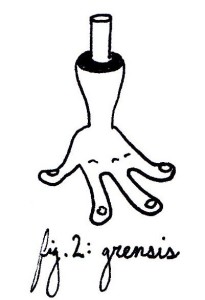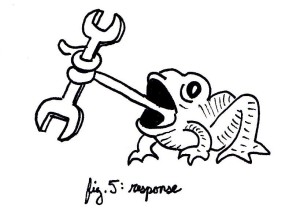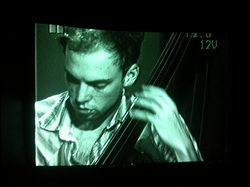Artist in Residence Update: Grensis
Editor’s note: Ben Willis is a musician and composer and one of our 2015-2016 artists in residence. As part of this program, artists in residence attend UMS performances to inspire new thinking and creative work within their own art forms.
Here, Ben is in conversation with Lester Crespum, an intuitive design specialist, explorer, and specious theorist.

Ben Willis: While I know I’m at risk of injecting my own biases and suppositions into this discussion, I’d like to talk to you about how you feel about being a multidisciplinarian, the expectations and challenges thereof, and also about this looming thing called the future, which all of us understand exists, but few of us really acknowledge.
Lester Crepsum: I’d like to begin with your second point.
BW: The future.
LC: Yes.
BW: Go ahead.
LC: (silence)
BW: Are you still there?
LC: Yes, I apologize, I was merely engaging with inevitability. I find that most claims are best reached when mediated by silence. In the case of the future, whose even existence is debatable – yet, inevitable, the question is more a case of the why than the what.
BW: Isn’t that always the case?
LC: I actually find the opposite to be true. I find myself asking “What?” and “What is that?” about pretty much everything. I also have an extremely poor short-term and long-term memory, requiring me to rely heavily on bionic augmentation.

BW: Technology?
LC: I’m currently in the process of developing, along with a team of technologists, a series of sensory augmentation ports that I could permanently inject into my spinal column.
BW: This will improve your memory?
LC: Better, it will be incredibly painful, which will serve as a constant reminder that I am alive. So often, when just sitting, or even in situations when I am being engaged, like now, I slip into an automatic mode of existence – of relying upon my own brain. While I know that I exist entirely within my own brain, and yes, since solipsisms (once radical, now boring!) are a thing, YOU, and EVERYTHING ELSE could very well (and probably do) exist entirely within my brain, it helps to be reminded that I’ve chosen to believe otherwise. These sensory augmentation ports in my spinal column would serve as nodes of interaction with the outside world, hyperventilated and fabricated pituita serving as divine access to the noumenal. (And by noumenal, I mean anything that isn’t me, of course, or at least everything that isn’t me and also isn’t my brain, which could very well be nothing. Thankfully, there’s so much more nothing than there is something! That’s where those questions “What?” and “What is that?” come in handy. Most of the time, the answer is “I don’t know!” or, even more aggravating, “What?”)

BW: Let’s talk about that parenthetical. You find the answer is often the question, “What?”
LC: What?
BW: I see.
LC: The future is mostly a realm of expectation. It will be or it won’t. Where do you think we will be in five years?
BW: What?
LC: Exactly! When I was embedded with the Zintook tribe in southern Smibwenbia, one of the most useful things I learned was a form of greeting. Between men, this was enacted by taking each others’ hands, making direct eye contact, and very slowly bringing your tongues to touch. The rest of the men would form a circle around you making a falsetto “Lululu” sound, in imitation mockery. Between a man and a woman, the greeters would lightly take each others’ hands, and then the woman would smack the man in the face, backhand, and then laugh. Between two women, they would just make eye contact, wink at each other, and then smile impishly. If there were other genders present, or gender fluid individuals, they would just pick one of these actions and perform it. Which was kind of more fun for the other person, if they didn’t know what was going to happen, like if a man starts going for the tongue thing, and then gets backhanded in the face! I’ve never laughed so hard.
BW: I’ve never heard of this tribe.
LC: Yes, sadly, they are largely decimated by now. And those left mostly act as weapon runners.
BW: It’s a cruel world.
LC: Business is booming for cruel people.

Interested in more? Follow the adventures and process of other UMS Artists in Residence.
UMS Artists In Residence: Meet Ben Willis
Editor’s note: UMS is in the second season of its Artists in “Residence” program. Five residents from across disciplines take residence at our performances throughout our season. We’ll profile each resident here on UMS Lobby.
Ben Willis is a bassist, improviser, and composer whose affinities lie in collaborative projects, new music, improvisation, and the merging of cross-disciplinary elements. He released an album of solo double bass compositions, Egret/Flatlander, in summer of 2015. His jazz-rock band, Lovely Socialite, will be releasing their second album, Toxic Consonance, in fall of 2015. He lives in Ypsilanti, MI, and performs often throughout the midwest.
UMS: Tell us a little about yourself and your background in the arts.
 Ben Willis: I did my undergraduate degree in classical performance, and have been playing in orchestras since middle school. While in Madison, WI, I was able to meet a community of musicians interested in making original, creative music. Though I’ve always kind of kept a foot in the classical world, after college I began playing a lot with my own bands, playing as a sideman for singer-songwriters, and working with artists of other performing arts (dance, theater, video) to develop new works. I came to the University of Michigan in 2012 to study improvisation, in order to extend my collaborative tool set. I’ve always been the kind of person who wants to do everything, so while I’m a performing artist by training/trade, I also try to work in other mediums (drawing, writing) as a hobbyist. I’m interested in being able to at least appreciate all art forms.
Ben Willis: I did my undergraduate degree in classical performance, and have been playing in orchestras since middle school. While in Madison, WI, I was able to meet a community of musicians interested in making original, creative music. Though I’ve always kind of kept a foot in the classical world, after college I began playing a lot with my own bands, playing as a sideman for singer-songwriters, and working with artists of other performing arts (dance, theater, video) to develop new works. I came to the University of Michigan in 2012 to study improvisation, in order to extend my collaborative tool set. I’ve always been the kind of person who wants to do everything, so while I’m a performing artist by training/trade, I also try to work in other mediums (drawing, writing) as a hobbyist. I’m interested in being able to at least appreciate all art forms.
UMS: Can you tell us a little about your creative process? Where can we find you working on your art?
BW: As an improviser, a lot of ideas kind of build gradually over time–I find in performance that sometimes things re-surface, and it’s helpful to isolate things that don’t feel improvised anymore as their own things. Another way I like to work, since most of my work is collaboratively generated, is to choose the people I’d like to work with first, and then develop the art spontaneously through the process of meeting/playing with others.
UMS: What inspires your art? Can you tell us about something you came across lately (writing, video, article, piece of art) that we should check out too?
BW: I am constantly inspired by my friends and collaborators. The best thing about being an artist is getting to know other artists, experiencing their process, and developing years-long artistic relationships. On another front, I’ve just recently become very interested in comics and graphic storytelling–some favorite books I’ve just read in that vain in the past few months are Charles Burns’s Black Hole, Jules Feiffers’s Kill My Mother, and Jodorowsky/Moebius’s The Incal. It’s really inspiring to experience works that make essential use of the combination of mediums (and the static experience of the printed page–so much of how films are made are taken from the style of comics these days, but there are a lot of things that the comic medium can just do better). I’ve also been re-reading some of my favorite Haruki Murakami books. And if you haven’t seen Oskar Schlemmer’s theater works/costume designs, do yourself the favor of going down that Google wormhole sometime.
UMS: Are you engaged with the local arts community? Tell us about groups or events that we should know about.
BW: I joined the Arbor Composers Collective in 2012, an ensemble started by composer/trumpeter Derek Worthington. That has been a great resource for developing new ideas and working with great musicians, and we present performances regularly. Our next performance is at Edgefest, presented by Kerrytown Concert House on October 21st. I also perform and have had a hand in booking many performances at Canterbury House, another great resource/platform in Ann Arbor for creative music. In the last year, I’ve been involved in the Radical Sounds Detroit series, which is curated by veteran Detroit composer/performer James Cornish, and presented by Spread Art at Detroit Contemporary. I’ll be guest curating the event on November 21st. I also teach private lessons, do workshops/sectionals at schools, and play in several bands that perform in the area, including Battleshags, The Great Collapsing Hrung, and Saajtak. You can check out a complete list of my upcoming performances.
UMS: Which performances are you most excited about this season and why?
BW: Sankai Juku’s UMUSUNA looks bonkers. I can’t wait. I’ve also been a longtime fan of Shara Worden, and more recently Tanya Tagaq, so I’m very much looking forward to their performances.
Interested in more? Watch for more artist profiles on UMS Lobby throughout this week.
Announcing 2015-2016 UMS Artists in Residence!

UMS has something to inspire everyone, from classical music, jazz, global, and indie music, to dance and theater. From left to right, artists on our 2015-2016 season: Hubbard Street Dance Chicago, to perform works of dance pioneer William Forsythe; My Brightest Diamond, who opens our season with the Detroit Party Marching Band; theater and cabaret artist Taylor Mac; violinist Gil Shaham, whose performance of Bach’s violin partitas collides with the iconic film world of David Michalek, and Antigone by Sophokles, in a new translation by Ann Arbor’s Award-winning poet Anne Carson. Photos courtesy of artists.
UMS is pleased to announce the second installment of our artists in “residence” program. Why “residence” in quotes? Because instead of a traditional artist residence, during which artists quite literally live at the place where the artist residency is located, we’re asking area artists to take residence at our performances.
We received many wonderful applications. Thanks to all who applied for the chance to experience your work.
Five artists (including visual, literary, and performing artists) have been selected to take “residence” at UMS performances, using these experiences as a resource to support the creation of new work or to fuel an artistic journey. Residents will receive complimentary tickets to select UMS performances; a $500 stipend; gatherings with fellow residents; and behind-the-scenes access to UMS staff and artists, when available. In return, UMS asks that artists share their artistic journeys via residency entrance and exit interviews and on the umslobby.org blog; participate in select UMS Education & Community Engagement events; and share artistic work generated during the residency when possible. Rights to all artistic work produced as a result of the residency will remain entirely with the artists.
Introducing our 2015-2016 artists in residence
Russell Brakefield received his MFA in poetry from the University of Michigan’s Helen Zell Writers’ Program. He lives in Ann Arbor where he teaches writing at the University of Michigan and works as a bookseller and as the managing editor for Canarium Books. His most recent work appears in The Southern Indiana Review, Hobart, and Language Lessons: An Anthology by Third Man Records.
Siobhan McBride was born in Seoul, South Korea and currently lives in Ann Arbor. She received her MFA in painting from the University of Pennsylvania in 2005. She was an artist in residence at Yaddo, Jentel, Lower Manhattan Cultural Council’s Workspace Program, Roswell Artist-in-Residence Program, and the Vermont Studio Center. Her work has been exhibited at NURTUREart, the Pelham Art Center, Eight Modern, and this past winter at Miami Project with DC Moore.
Helena Mesa is the author of Horse Dance Underwater and a co-editor for Mentor & Muse: Essays from Poets to Poets. Her poems have appeared in various literary journals, including Indiana Review, Pleiades, Third Coast, and Puerto del Sol. She has been a fellow at the Virginia Center for the Creative Arts, Hambidge Center for the Creative Arts & Sciences, and Writers in the Heartland. She lives in Ann Arbor and teaches at Albion College.
Andrew Morton’s plays include Bloom (a winner at the 2013 Write Now Festival and winner of the 2013 Aurand Harris Memorial Playwriting Award), which received its world premiere at Flint Youth Theatre in May 2014 and was subsequently published by Dramatic Publishing, Inc. Other works include: February (shortlisted for the 2007 Royal Court Young Writers Festival), Drive-Thru Nativity, and the collaborative projects State of Emergency, EMBERS: The Flint Fires Verbatim Theatre Project, and the upcoming The Most [Blank] City in America, premiering at Flint Youth Theatre in April 2016. As a community artist and educator, Morton has worked with a range of organizations across the globe, including working alongside Salvation Army community counselors in Kenya to incorporate participatory theatre into their work with people living with HIV/AIDS. While based in the UK, he worked with several educational theatre companies and was the Education Officer at the Blue Elephant Theatre where he ran the Young People’s Theatre and the Speak Out! Forum Theatre projects. Morton is currently based in Flint, Michigan where he teaches at the University of Michigan-Flint and is Playwright-in-Residence at Flint Youth Theatre.
Ben Willis is a bassist, improviser, and composer whose affinities lie in collaborative projects, new music, improvisation, and the merging of cross-disciplinary elements. He released an album of solo double bass compositions, Egret/Flatlander, in summer of 2015. His jazz-rock band, Lovely Socialite, will be releasing their second album, Toxic Consonance, in fall of 2015. He lives in Ypsilanti, MI, and performs often throughout the midwest.
You’ll be able to follow the artists’ journeys throughout the UMS season right here on UMS Lobby.
In this video, 2014-2015 residents chat about what they loved about the program.
Interested in learning more? See this season’s application requirements.
Members of the media interested in more information about the program should contact Anna Prushinskaya, manager of digital media, at annavp@umich.edu. Download press release


